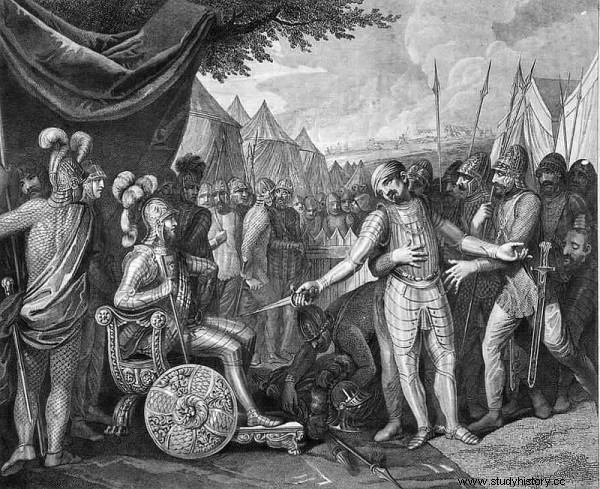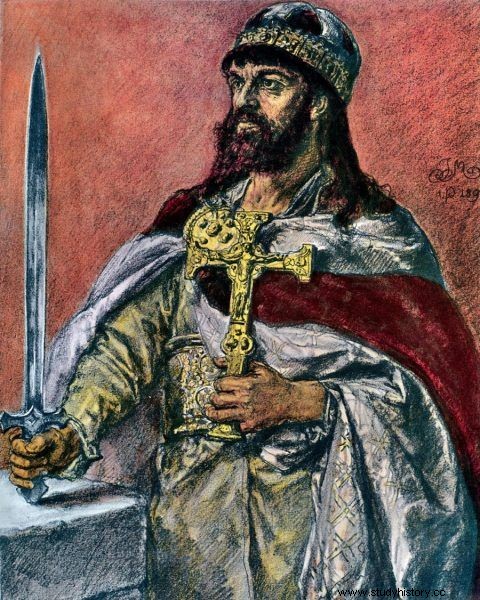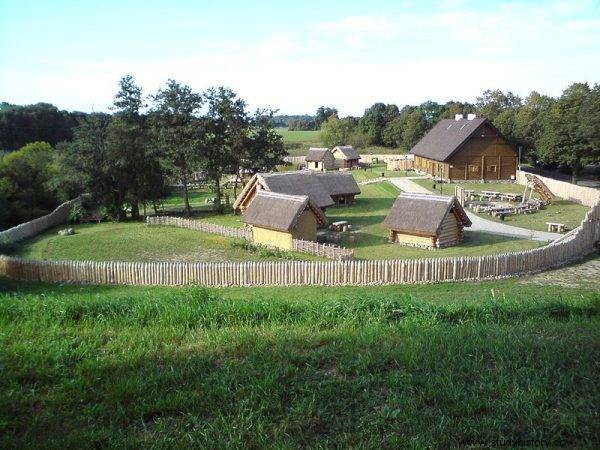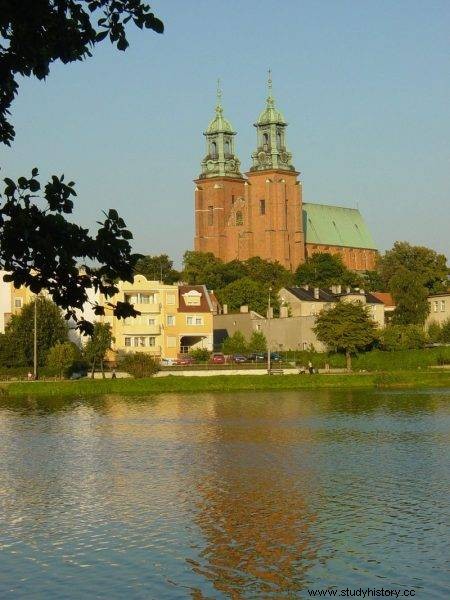According to the chronicler, they came from a simple peasant Piast, whose son Siemowit founded the dynasty and peacefully seized power, but the idyllic version of their history has nothing to do with reality. The future rulers of Poland made their way to power with a bloody conquest.
They are a phenomenon for historians. It is not known where they came from. It is known that within several dozen years they conquered all the castles of local warlords in Greater Poland. They demolished their seats, but built their own - more powerful ones. The seizure of power by the Piasts was a revolution in the tribal world, which resulted in the uprising of Poland, and was accomplished through terror.
The chronicler Gall Anonymous was the first to mention the noble plowman Hub. He was to take under his roof two wanderers who had been rejected earlier by the evil Prince Popiel. He had haircuts - an ancient pagan rite of the transition of an adolescent boy from his mother's tutelage to his father's care, consisting in a symbolic haircut.
The wanderers, without being hosted by Popiel, found themselves under the roof of the modest Piast, who also organized haircuts - Siemowit's son. The poor plowman, although he himself had little, did not refuse the visitors either food or drink. The visit of the guests turned out to be miracles. Beer and meat multiplied, and Piast managed to feed them all, and he still had some left. Strangers sheared the landlord's son and named him Siemowit, who - as the chronicler writes - became so respected and valued that " the king of kings and the prince of princes with common consent made him the prince of Poland and Popiel and his offspring were completely removed from the kingdom. ”
Thus, through a peaceful path, wearing white gloves, one could say - the Piast Poland was born. The version of the Piast legend about Popiel from Kruszwica, who was eaten by mice, is over 100 years later than the administration of Gallus Anonymus.
Raid
Thanks to dendrochronological dating and specific construction technology, it is possible to determine exactly how the Piast expansion took place. In less than half a century, an anonymous family built a state with which the German empire and other neighbors were important. Historians emphasize that the country of the previously unknown Piasts simply "exploded".
"For outside observers, Mieszko's state appears like a devil out of the box, he surprises everyone" - commented in the documentary "The Hidden Nest of the Dynasty" prof. Przemysław Urbańczyk.

Historians emphasize that the country of the previously unknown Piasts simply "exploded".
The ruthless conquest is evidenced by the archaeological remains of strongholds in Greater Poland, which fell victim to brutal invasions in the 10th century. Scientists have located as many as 90 tribal seats from the beginning of the 10th century. Several dozen years later, when Mieszko was already in power, only a dozen of them survived.
The rest was conquered and destroyed - most likely by the Piasts. The invasion took place suddenly. Research indicates that after 920, an armed group took turns conquering and blowing up more tribal centers . Researchers believe that the perpetrators of this terror were the Piasts . The people from the conquered strongholds were relocated to the Gniezno plateau - as a workforce needed to build new, much more powerful castles. Material evidence of the new lordship of these lands and a new order.
Dago of the Varangians, king of the north?
Brutal and at the same time extremely consistent conquest of the cradle of the future state, it took the Piasts only several dozen years. The Polan tribe, identified with the first dynasty of the new state, did not appear in the records of chroniclers for a long time. The name Polanie appears in sources later than tribal times. Today, researchers question not only the affiliation of the Piasts to Polans, but also the existence of such a tribe.
So who were those who took power and started building their own castles? The first mention of Mieszko's country - by an Arab merchant of Jewish origin - Ibrahim ibn Jakub, speaks of the country of the "king of the North" - as Mieszko calls him - and mentions his military strength. As he says: the ruler's team consisted of 3,000 armored men, and "a hundred of them were worth as much as ten seconds of others".

Even Thietmar emphasized that margrave Hodo attacked Mieszko without the emperor's consent.
There is no doubt that the family that stood out among the local tribes and clans must have had the appropriate strength, but could one of the local groups be able to do it? Such questions provoke researchers to formulate hypotheses about the foreign origin of the Piasts.
One of the theories sees the founders of Poland as Scandinavian . Even in the nineteenth century, it was assumed that in the sixth century AD, newcomers from Scandinavia called ... Lachs were to reach the Warta River. They were to create the country in Greater Poland. Another version of this hypothesis says that Mieszko was to be a Danish commander named Dago, who in the middle of the 10th century came to Greater Poland from Kievan Rus conquered by the Varangians, also conquered the local tribes and founded the future Polish state.
The premise for this theory is to be Dagome iudex released at the end of Mieszko's reign. This document, putting the country under the protection of the Pope, does not mention the ruler - Mieszko. Instead, the term Dagome appears. Why not Mieszko? Is Dagome / Dago the real name of the Scandinavian warrior who conquered Greater Poland?
The thesis about the Scandinavian, i.e. Germanic conquest of the Slavs was willingly used in Nazi Germany as a proof of the German "right" to the lands in the east. Scientists, however, today reject the Scandinavian hypothesis. The term Dagome appears only once, in this document, and besides, all contemporary accounts describe Mieszko as a Slav.
Another "foreign" hypothesis tells about the arrival of Slavs to Greater Poland - migrants from the south - descendants of the elite of the Great Moravian state, broken by Hungarian tribes. The "Great Moravian" theory is supported by the fact that a new political organization was established in Greater Poland "out of nowhere". Maybe the refugees from Moravia contributed to it? The dukes of Great Moravia could get to the north. Perhaps they offered the Piasts help in organizing the state?
Kalisz paradise
The hypotheses about external inspiration do not yet have strong foundations. Scientists see rather the local origin of the Piasts, but there are also a number of white spots here. Modern research shows that Gniezno was not the original seat of the family.
We learn from dendrochronological research that in the winter of 940 the trees for the construction of the Gniezno stronghold were cut down. There were already older Piast seats in operation. Scientists have identified a construction "special sign" which allows to determine that a given stronghold was built by the ancestors of Poland. This kind of "fingerprint" are fragments of thick boughs protruding from the beams used to build the hillforts. These branches formed hooks that allowed the "installation" of the parallel beams. Hook structures are a remnant of the Piasts.
So where did those who pursued their desire for greatness with such determination and consistency?

Researchers selected the town in Giecz as the original seat of the Piasts, from which their expansion began.
Researchers selected the town in Giecz for the original seat of the Piasts, from which their expansion began. Its origins date back to 865. How important Giecz was for the Piasts can be seen in the account of Gallus Anonymus, which says that in the times of Mieszko this center was manned with 300 armored men and could field 2,000 shield-bearers. Moreover, the Piasts did not destroy Giecz during the conquest of Greater Poland, as was the case with other settlements.
The problem is that Giecz, if it was really the cradle of the Piasts, could not be abandoned, and this is what happened after the extremely devastating invasion of the Czech prince Brzetysław. The Czechs completely destroyed Giecz, which the Piasts never rebuilt afterwards. "If it was the cradle of the Piasts, then I ask myself:why was it so quickly forgotten about your family nest?" - commented prof. Andrzej Buko in the documentary "The Hidden Nest of the Dynasty".
Another hypothesis sees the Piast cradle in Kalisz. There, on the Prosna River, the original stronghold of the family from which the Piasts would start their expansion would be located. Scientists have identified many adventure settlements as well as the original course of the Prosna River. The stronghold was situated on an island surrounded by its current. Scientists have discovered here wood and earth fortifications, the remains of a fortified stronghold, built about 100 years before Mieszko. What's more, only 5 km from the Zawodzie town in Kalisz, where the original stronghold was located, scientists have located another one.
Was the legendary Siemowit ruled here and this is where the Piast road to power began? The research shows that there was a lot of life around two castles, there were many settlements. Agriculture, livestock, craft and trade developed. With time, along with prosperous life, the ambition of local rulers to expand the area of ownership could arise.
P iastów construction site
According to researchers, the main goal of the Piasts was to capture Gniezno. Their expansion was directed in this direction, because it was there, at the so-called Lech Hill, there was a pagan cult object - important for all local family groups. Taking over Lech Hill gave a symbolic right to rule the entire local community.
Before that happened, the Piasts had to subjugate the towns of south-western Wielkopolska. They did it gradually but consistently.

The Gniezno Cathedral on the Lech Hill
The people of the conquered lands were harnessed to work on the great clearing of forests and building new, heavily fortified residences. Around 940, new castles were built in Poznań and Gniezno. Around 963/964, probably Mieszko I ordered the construction of huge bridges leading to the stronghold on the Ostrów Lednicki island. The bridge from the side of Gniezno was 187 meters, the second one - towards Poznań - 438 meters.
In turn, perhaps the ancestral seat of the Piasts in Kalisz was rebuilt and significantly enlarged . The area of the hillfort was almost 2 hectares. The theory about the cradle of the Piasts in Kalisz seems to be confirmed by the fact that in the area, within a radius of 20 km, the remains of as many as 24 smaller forts were discovered - watchtowers defending the main site.
So was it from Kalisz that the Piasts' road to power began? The phenomenon of the emergence of "out of nowhere" state, which immediately counted on the map of Europe at that time, took part in political games and was an important point of reference for such powers as the German Empire, provokes further searches for the source of Piast power.
It is certain that the first historical ruler of the state - Mieszko - was already well "seated in the saddle" , he managed a strong and organized country - the work of his predecessors. Mieszko did not waste the potential they had developed. During his lifetime, by means of further conquests, connections and political alliances, he subjugated an area several times larger than his native cradle, almost completely consistent with the map of today's Poland.
Filmography:
- The Hidden Nest of the Dynasty , directed by:Zdzisław Cozac.
- Ruler Island , directed by:Zdzisław Cozac.
- The way to the kingdom , directed by:Zdzisław Cozac.
Bibliography:
- Polish Chronicle, Gall Anonim , series "Polish Chronicles", Zakł. Nard. Ossoliński, Wrocław.
- Jasiński K., Pedigree of the first Piasts , Wrocław - Warsaw 1992.
- Przemysław Urbańczyk, Before Poland became Poland , Toruń 2015.
